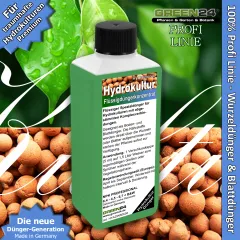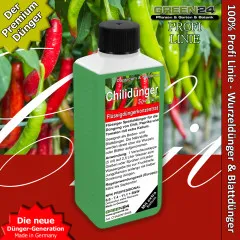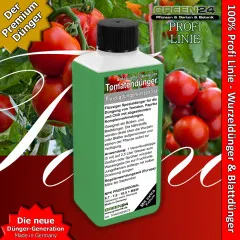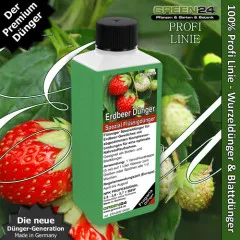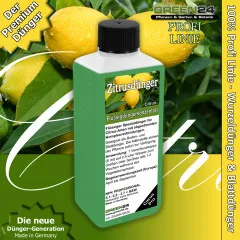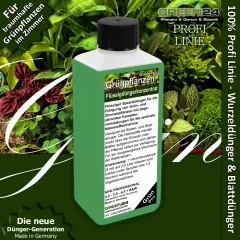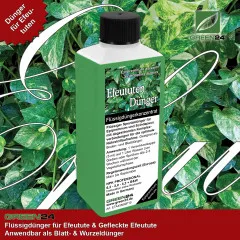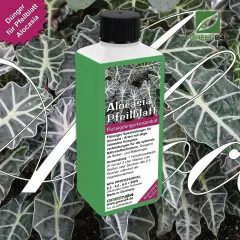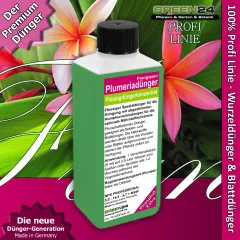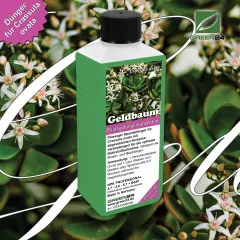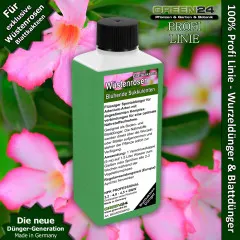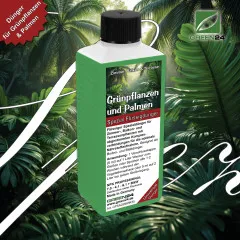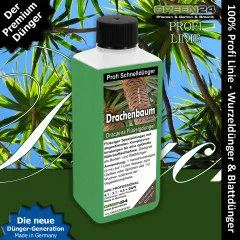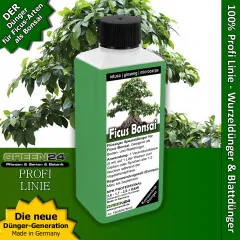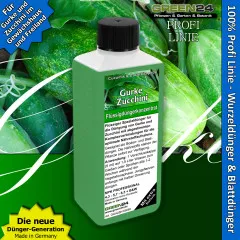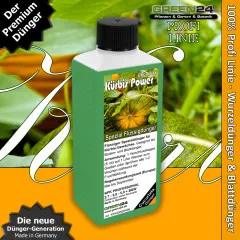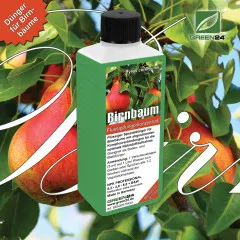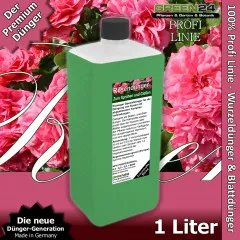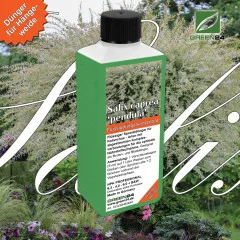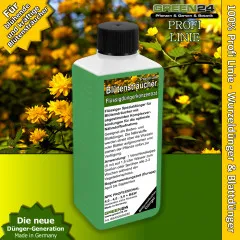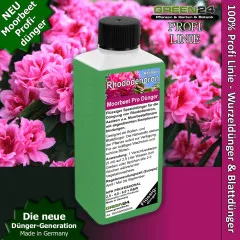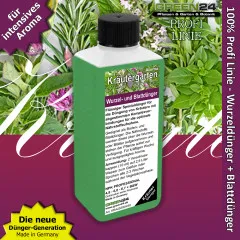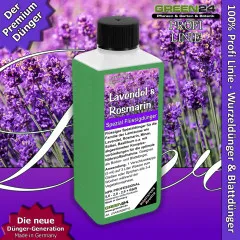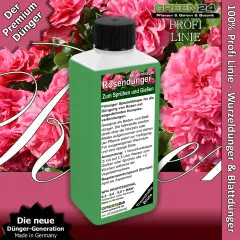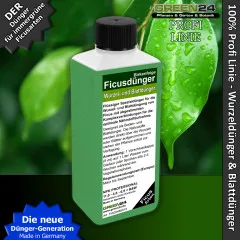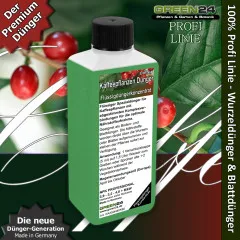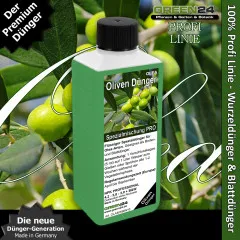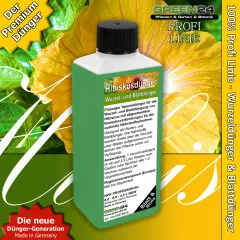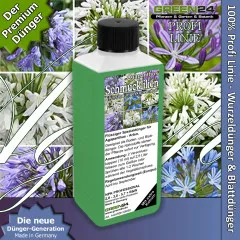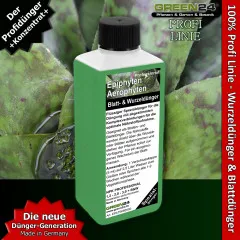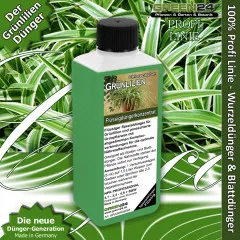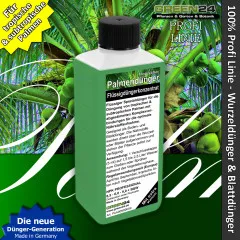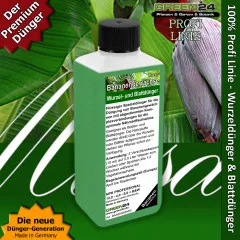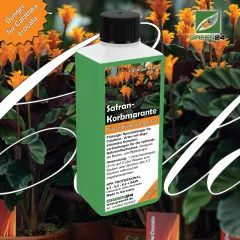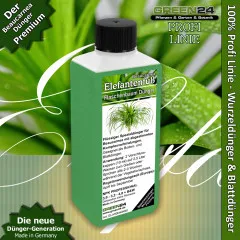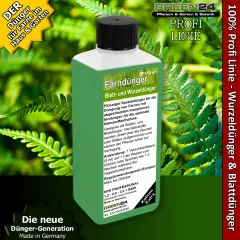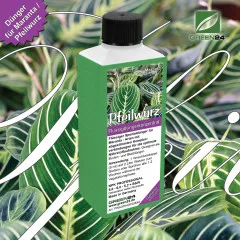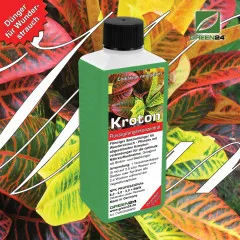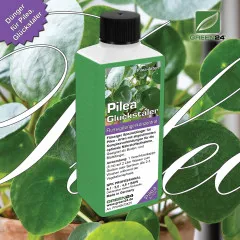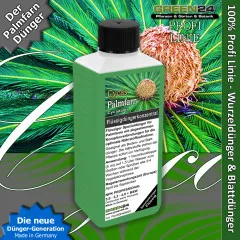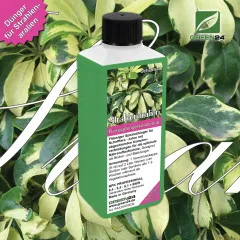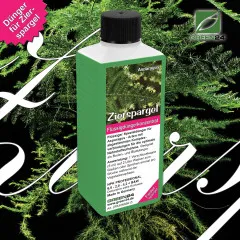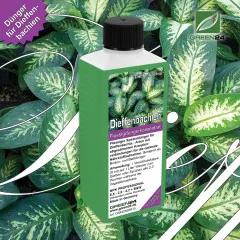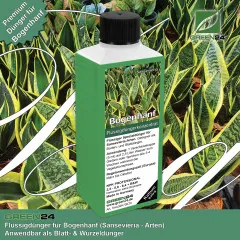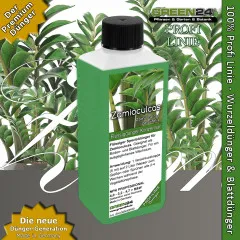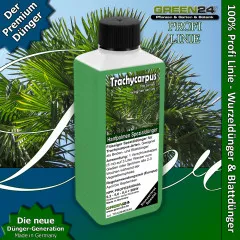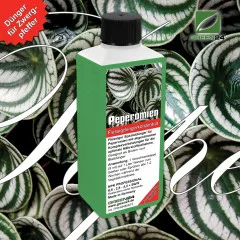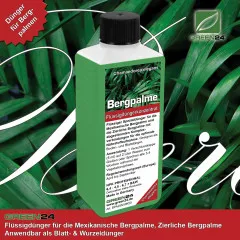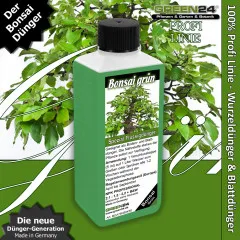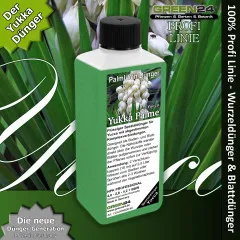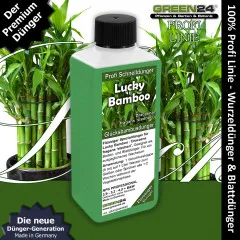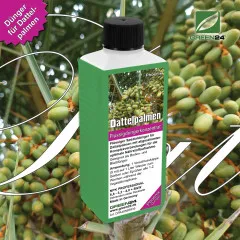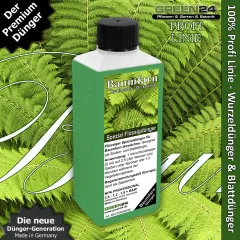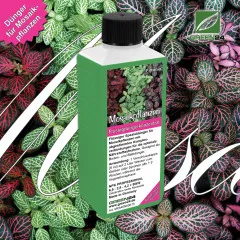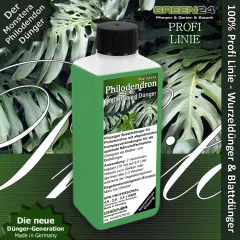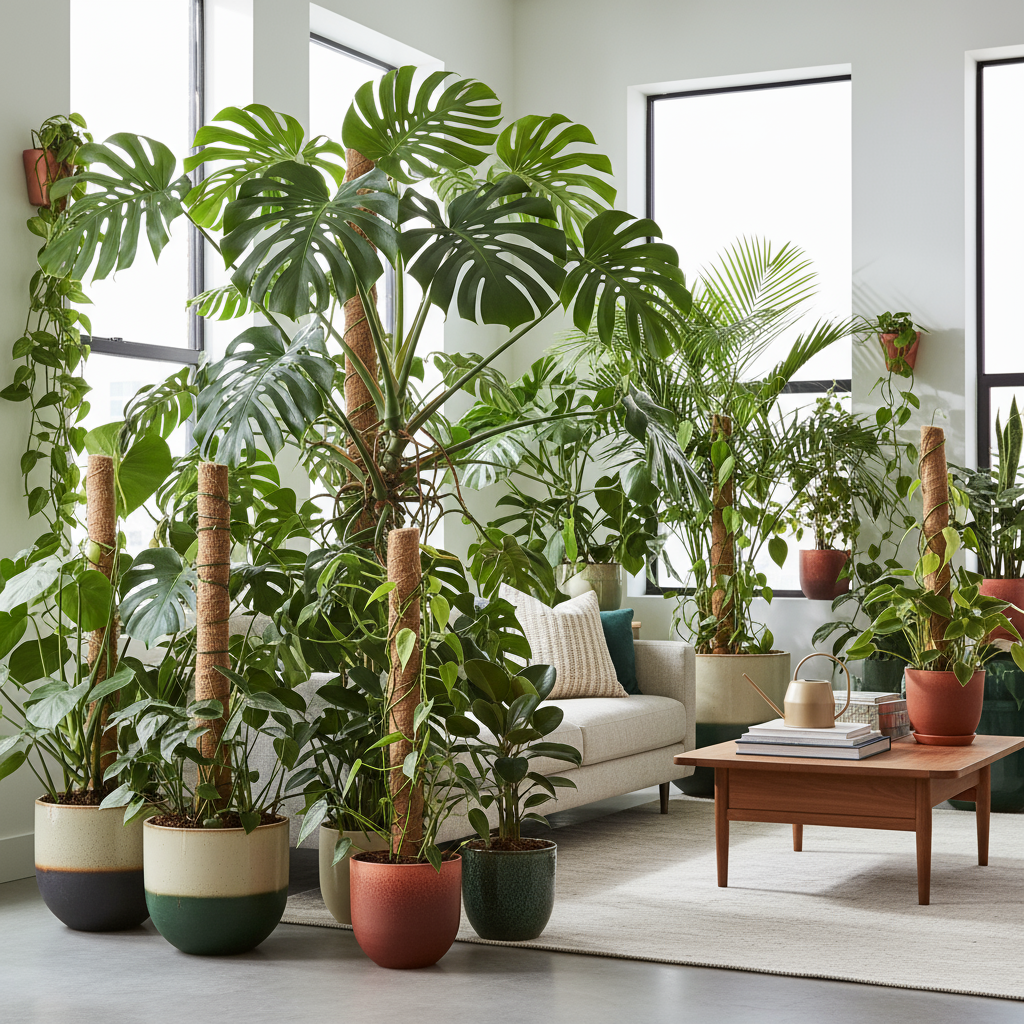
Tropical Leaf Giants: GREEN24 Special Fertilizer for Authentic Aroideae
Successful cultivation of Monstera and Philodendron requires special knowledge about the particular needs of tropical foliage plants. Aroideae as spectacular houseplants have special nutrient requirements and need balanced NPK supply with important trace elements for lush leaf growth, strong aerial roots and healthy development in indoor culture for maximum success. Our Monstera & Philodendron fertilizer is specially adapted to the needs of Aroideae species and offers professional houseplant technology for maximum growth success.
Plant Profile: Monstera & Philodendron (Aroideae)
- Monstera (Swiss Cheese Plant):
- Family: Araceae (Arum family)
- Origin: Tropical rainforests of Central and South America
- Growth form: Climbing epiphytes with aerial roots
- Special feature: Characteristic leaf holes (fenestration)
- Philodendron (Tree Friend):
- Family: Araceae (Arum family)
- Origin: Tropical rainforests of the Americas
- Growth form: Climbing and bush forms
- Special feature: Diverse leaf shapes and colors
- Botanical characteristics:
- Scientific names: Monstera spp., Philodendron spp.
- Synonyms: Swiss Cheese Plant, Tree Friend, Split-leaf Philodendron
- Height: 1-3m (in cultivation), up to 20m (natural habitat)
- Width: 1-2m (in cultivation)
- Growth rate: Medium to fast
- Life expectancy: Over 20 years possible
- Leaf characteristics:
- Leaf shape: Heart-shaped to deeply split
- Leaf size: 20-90 cm long, 15-75 cm wide
- Leaf color: Green to dark green, partially variegated
- Leaf margin: Entire to deeply split
- Leaf arrangement: Alternate
- Special feature: Fenestration in Monstera, diversity in Philodendron
- Popular Monstera species:
- Monstera deliciosa:
- Delicious Swiss Cheese Plant
- Large leaves with characteristic holes
- Classic houseplant
- Very robust and easy-care
- Monstera adansonii:
- Small Swiss Cheese Plant
- Smaller leaves with many small holes
- Compact growth
- Ideal for smaller spaces
- Monstera obliqua:
- Rare collector's species
- Extreme fenestration
- Very thin leaves
- More difficult to cultivate
- Monstera variegata:
- Variegated forms
- White-green leaves
- Very sought after
- Slower growth
- Monstera deliciosa:
- Popular Philodendron species:
- Philodendron scandens:
- Climbing Tree Friend
- Heart-shaped leaves
- Very easy-care
- Ideal for beginners
- Philodendron hederaceum:
- Ivy Tree Friend
- Small heart-shaped leaves
- Trailing or climbing
- Very robust
- Philodendron bipinnatifidum:
- Large Tree Friend
- Deeply split leaves
- Bushy growth
- Impressive appearance
- Philodendron erubescens:
- Red Tree Friend
- Reddish petioles
- Climbing growth
- Attractive coloring
- Philodendron scandens:
- Location characteristics:
- Light: Bright partial shade to bright indirect light
- Soil: Well-draining, humus-rich
- pH value: 5.5-7.0 (slightly acidic to neutral)
- Moisture: Evenly moist, no waterlogging
- Temperature: 18-25°C optimal
- Humidity: High (60-80%)
- Winter hardiness:
- Frost sensitive: Only frost-free cultivation
- Minimum temperature: 15-18°C
- Overwintering: Bright and warm
- Winter dormancy: Reduced growth with less light
- Cultural characteristics:
- Bright partial shade to bright indirect light
- Well-draining, humus-rich substrate
- Even watering, avoid waterlogging
- Regular fertilizing: Weekly during growing period
- High humidity (60-80%)
- Climbing aids for climbing species
- Critical factors: Waterlogging, too dark location, too dry air, over-fertilizing with nitrogen
- Common problems: Yellow leaves, brown leaf tips, no fenestration, pests, weak growth
The Science of Aroideae Nutrition
The Monstera & Philodendron Formula "Tropical Leaf Power"
Monstera and Philodendron as tropical foliage plants have special nutrient needs for optimal leaf growth and aerial root development:
- Nitrogen (N) for leaf growth: Essential for the development of characteristic large leaves. Nitrogen is the key to lush leaf growth and intense green coloring.
- Phosphorus (P) for root formation: Promotes the development of strong aerial roots and soil roots. Phosphorus is important for energy transfer in the plant.
- Potassium (K) for leaf quality: Strengthens leaf structure and improves resistance. Potassium is important for robust plants.
- Iron (Fe) for chlorophyll: Important for chlorophyll formation and prevents iron chlorosis (yellow leaves with green veins).
- Manganese (Mn) for enzyme activity: Activates important enzymes in plant metabolism and supports photosynthesis.
- Trace elements for vitality: Copper, zinc, boron and molybdenum are essential for entire plant metabolism and leaf quality.
- Complex compounds: Specially developed compounds for maximum nutrient availability and fast uptake.
- Aroideae adaptation: Specially developed for the needs of tropical arum plants.
Application: Professional Monstera & Philodendron Care
Standard Fertilizing (Main Application)
For spectacular leaf growth and strong aerial roots
- Timing: Weekly during growing period (March-October)
- Frequency: Regular during vegetation period
- Dosage: 1 cap (5ml) per 1-1,25 liter water
- Application: As watering solution directly to roots
- Advantage: Optimal nutrient supply for leaf growth
- Special feature: NPK balance for maximum leaf development
Growth-Intensive Fertilizing (Special Application)
For maximum leaf growth and aerial root formation
- Timing: During main growing season (April-September)
- Frequency: 2x weekly during intensive growth phase
- Dosage: Normal concentration with focus on nitrogen
- Application: Regular watering fertilization
- Especially important: Continuous application for continuous growth
- Additional benefit: Promotes fenestration in Monstera
Foliar Fertilizing (Supplementary Application)
For fast nutrient uptake through leaves
- Timing: In case of nutrient deficiency or as supplement
- Dosage: Half concentration for leaf spraying
- Application: Spray on leaf upper and lower surfaces
- Especially important: Apply in morning or evening
- Additional benefit: Simultaneously increases humidity
Care Instructions for Successful Aroideae Culture
Optimal Conditions for Monstera & Philodendron
- Light: Bright partial shade to bright indirect light, no direct sun
- Temperature: 18-25°C optimal, minimum 15°C in winter
- Humidity: High (60-80%), regular misting
- Watering: Evenly moist, let dry between waterings
- Substrate: Well-draining, humus-rich, pH 5.5-7.0
- Drainage: Very important against waterlogging and root rot
Aroideae-Specific Care
- Climbing aids: Moss poles or trellises for climbing species
- Aerial roots: Do not remove, guide into substrate
- Repotting: Every 2-3 years in well-draining substrate
- Pruning: Only when necessary, use clean cutting tools
- Propagation: Cuttings or offshoots
Special Features of Monstera & Philodendron Culture
Species-Specific Application
Optimally supply different Aroideae species
- Monstera deliciosa: Intensive fertilizing for large leaves
- Monstera adansonii: Moderate fertilizing, compact growth
- Philodendron scandens: Regular fertilizing for climbing growth
- Young plants: Weaker fertilizing, more growth focus
- Potted plants: More intensive fertilizing due to limited root space
Growth-Optimized Fertilizing
- Spring: Nitrogen-rich fertilizing for sprouting
- Summer: Balanced fertilizing for continuous growth
- Autumn: Reduced fertilizing, winter preparation
- Winter: Fertilizing break with little light
Seasonal Aroideae Care
- Spring: Intensive fertilizing for growth start
- Summer: Regular fertilizing and leaf care
- Autumn: Declining fertilizing, light adaptation
- Winter: Fertilizing break, warm overwintering
Problem Solving Through Targeted Nutrient Supply
Common Monstera & Philodendron Problems and Their Solutions
- Yellow leaves: Nitrogen deficiency or overwatering → Nitrogen-rich fertilizing + adjust watering behavior
- Brown leaf tips: Too dry air or over-fertilizing → Increase humidity + reduce fertilizing
- No fenestration: Too little light or too young → Brighter location + patience
- Weak growth: Nutrient deficiency or unfavorable location → Fertilizing + optimize location
- Pests: Stress or unfavorable conditions → Optimal care + pest control
- Root rot: Waterlogging or too cold location → Improve drainage + increase temperature
Effects of Optimal Fertilizing
- Spectacular leaves: Large, healthy leaves with characteristic features
- Strong aerial roots: Healthy aerial root development for natural climbing
- Healthy growth: Vital, resistant plants
- Intense coloring: Rich green leaves without chlorosis
- High resistance: Resistance against diseases and pests
- Tropical appeal: Authentic rainforest atmosphere
Modern Aroideae Technology
Houseplant Culture (Main Application)
- Living room culture: Large specimen plants as eye-catchers
- Office greening: Easy-care green plants for workplaces
- Conservatory: Tropical atmosphere in protected spaces
- Urban jungle: Modern interior design with plants
Collector Culture
- Species collection: Different Monstera and Philodendron species
- Variegata collection: Variegated forms and rarities
- Size collection: From miniature to giant specimens
- Climbing garden: Different climbing aids and forms
Professional Application
- Interior landscaping: Hotels, offices and public buildings
- Nurseries: Professional cultivation and culture
- Plant rental: Temporary greening for events
- Hobby breeding: Own propagation and cultivation
Metabolism Optimization for Aroideae
Leaf Development
- Fenestration: Development of characteristic leaf holes
- Leaf size: Maximum leaf development with optimal nutrition
- Leaf color: Intense green coloring through sufficient nitrogen
Aerial Root Physiology
- Nutrient uptake: Additional nutrient supply via aerial roots
- Moisture uptake: Absorption of air humidity
- Climbing function: Support and stability when climbing
Stress Resistance
- Drought tolerance: Adaptation to changing conditions
- Light adaptation: Flexibility in different light conditions
- Regeneration ability: Quick recovery after stress
Frequently Asked Questions (FAQ)
How often should I fertilize my Monstera and Philodendron?
Fertilize weekly during growing season (March-October). Take fertilizing break in winter with less light.
Why doesn't my Monstera get holes in the leaves?
Common causes are too little light, too young plant or nutrient deficiency. Brighter location and regular fertilizing promote fenestration.
Can I use the fertilizer for other houseplants too?
The fertilizer is specially optimized for Aroideae but can also be used for other tropical houseplants.
Why do the leaves of my Philodendron turn yellow?
Yellow leaves can result from nitrogen deficiency, overwatering or natural aging. Adjust fertilizing and check watering behavior.
Should I remove the aerial roots?
No, aerial roots are natural and important for the plant. They can be guided into substrate or attached to climbing aids.
How do I recognize over- or under-fertilizing?
Over-fertilizing: Brown leaf tips, burned leaves. Under-fertilizing: Yellow leaves, weak growth, small leaves.
Binding Application Instructions
- Always observe information sheet 130405! You can find this at URL https://www.green24.de/NPK.pdf
- Always observe the label!
- Do not apply undiluted.
- Shake well before use.
- Only apply during vegetation period.
Safety Instructions
- Avoid contact with eyes, skin and clothing.
- Do not inhale spray and spray mist.
- Keep away from food and beverages.
- Wash face and hands thoroughly after use.
- Recommendations of official advisory services take precedence.
- Fertilizers may leave stains on surfaces that may not be removable.
Storage
- Store dry, dark at +8°C to +40°C.
- Keep out of reach of children and animals.
- Fertilizer must not be introduced into water bodies or reach sewage.
- With proper storage, keeps for several years without quality loss.
- Use diluted fertilizer promptly.

